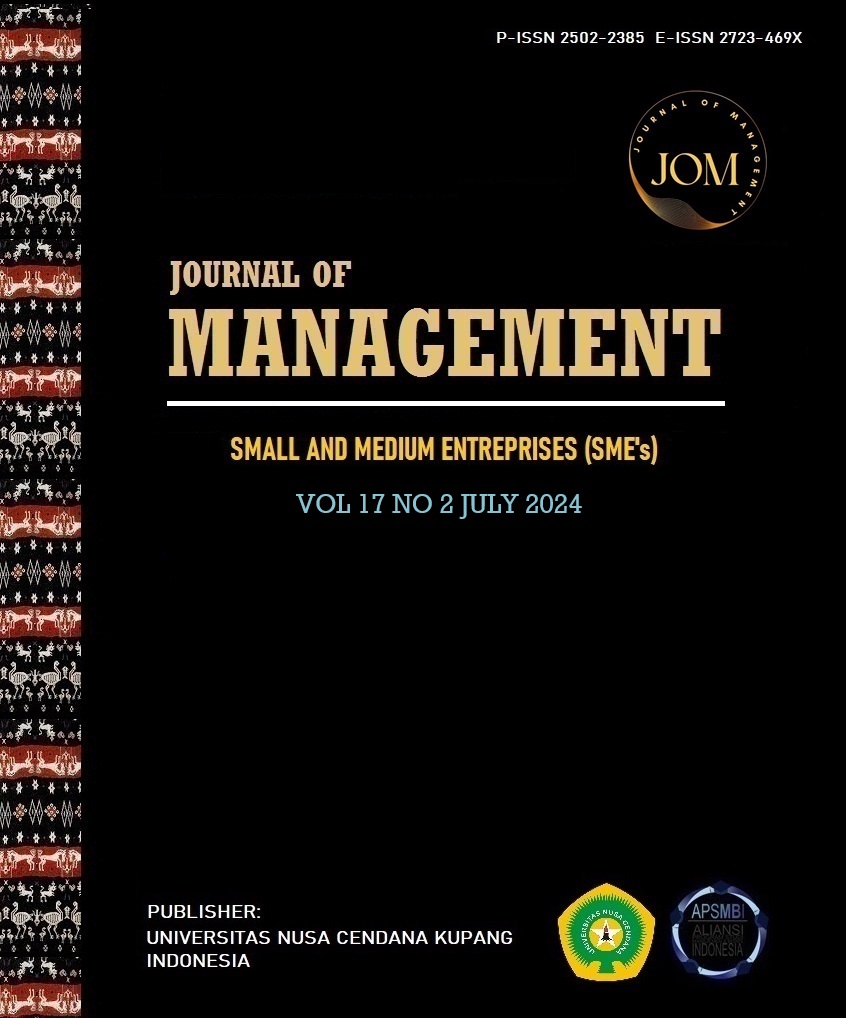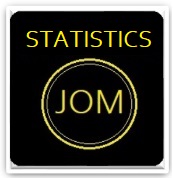ANALISIS RISIKO LIKUIDITAS PADA BANK UMUM SYARIAH DI INDONESIA
Abstract
Sharia Commercial Banks in Indonesia are experiencing rapid growth, as can be seen from the significant increase in sharia banking assets. As a result, Sharia Commercial Banks need to ensure bank liquidity is well maintained. This research evaluates the influence of liquidity and macroeconomic factors on the profitability of Sharia Commercial Banks. This research uses quarterly financial report data from 13 Sharia Commercial Banks during the 2018-2022 period. Sampling technique that used in this research was purposive sampling. The analysis method used is panel data regression. The research results show that the LATA and INF variables have a significant positive influence on ROA, while the CUR variable has a significant negative influence on ROA. Meanwhile, the LATD, FDR and GDP variables do not have a significant influence on ROA.
Keywords: Sharia Commercial Banks; Liquidity Risk; Macroeconomics; Bank Profitability
Downloads
References
Adesina, O. D., & Adewumi, A. A. (2022). The Effect of liquidity management on the Financial Performance of selected Deposit Money Banks in Nigeria. Fuoye Journal of Accounting and Management, 5(2), 2814–1717.
Alhusain, A. S. (2021). Bank Syariah Indonesia: Tantangan dan Strategi dalam Mendorong Perekonomian Nasional. Info Singkat: Bidang Ekonomi Dan Kebijakan Publik, 13(3), 19–24.
Alim, W., Ali, A., & Metla, M. R. (2023). The Effect of Liquidity Risk Management on Financial Performance of Commercial Banks in Pakistan. Journal of Applied Economics and Business, 9(4), 109–128.
Almansour, A. Y., Alzoubi, H. M., Almansour, B. Y., & Almansour, Y. M. (2021). The Effect of Inflation on Performance: An Empirical Investigation on the Banking Sector in Jordan. The Journal of Asian Finance, Economics and Business, 8(6), 97–102. https://doi.org/10.13106/jafeb.2021.vol8.no6.0097
Antony, T. M. (2023). Determinants of liquidity risk: Empirical evidence from Indian commercial banks. Banks and Bank Systems, 18(3), 101–111.
https://doi.org/10.21511/bbs.18(3).2023.09
Azmi, A., Adam, M., Widiyanti, M., & Malinda, S. (2022). Impact of US dollar exchange rate and inflation on profitability. International Research Journal of Management, IT and Social Sciences, 9(1), 131–137. https://doi.org/10.21744/irjmis.v9n1.2019
Egbunike, C. F., & Okerekeoti, C. U. (2018). Macroeconomic factors, firm characteristics and financial performance: A study of selected quoted manufacturing firms in Nigeria. Asian Journal of Accounting Research, 3(2), 142–168.
https://doi.org/10.1108/AJAR-09-2018-0029
Fasa, R. A. A., Nurdin, A. A., & Tripuspitorini, F. A. (2022). Pengaruh Likuiditas Terhadap Profitabilitas Pada Bank Umum Syariah di Indonesia Periode 2015-2020. Journal of Applied Islamic Economics and Finance, 2(2), 428–433.
https://doi.org/10.35313/jaief.v2i2.3043
Firmansyah, M., Masrun, & Yudha S, I. D. K. (2021). Esensi Perbedaan Metode Kualitatif Dan Kuantitatif. Jurnal Ekonomi Pembangunan, 3(2), 156–159.
Gupta, N., & Mahakud, J. (2020). Ownership, bank size, capitalization and bank performance: Evidence from India. Cogent Economics and Finance, 8(1), 1–39. https://doi.org/10.1080/23322039.2020.1808282
Hasyim, F., Pratiwi, N., Asmaradhan, bajwa salsabila, & Kurniyadi. (2023). The Effect of Exchange Rates, Inflation and BI Rates on Profitability in Islamic Commercial Banks During The 2016-2022 Period. Asy Syar’iyyah: Jurnal Ilmu Syari’ah Dan Perbankan Islam, 8(2), 162–184.
Ichsan, R. N., Suparmin, S., Yusuf, M., Ismal, R., & Sitompul, S. (2021). Determinant of Sharia Bank’s Financial Performance during the Covid-19 Pandemic. Budapest International Research and Critics Institute (BIRCI-Journal): Humanities and Social Sciences, 4(1), 298–309. https://doi.org/10.33258/birci.v4i1.1594
Kadam, M. M., & Sapkal, D. (2019). A Comparative Analysis of Performance of Public and Private Sector Banks in India through CAMEL Rating System. International Educational Applied Research Journal, 3(1).
Kalimashi, A., Ahmeti, S., & Aliu, M. (2022). The Relationship between Liquidity Risk Management and Commercial Bank Performance: Evidence from the Western Balkans. International Journal of Applied Economics, Finance and Accounting, 14(2), 129–136. https://doi.org/10.33094/ijaefa.v14i2.689
Kulsum, U., Fatkar, B., Mulatsih, S. N., Alicia, R., & Erdi, H. (2023). Analysis of Capital Adequacy Ratio (Car), Non Performing Financing (Npf) and Financing To Desposito Ratio (Fdr) To Profitability Return on Asset (Roa) At Bni Syariah Bank for the 2011-2020 Period. Jurnal Scientia, 12(1), 388–398.
http://infor.seaninstitute.org/index.php/pendidikan/article/view/1115/888
Kusdiana, Y., & Safrizal, S. (2022). Faktor-Faktor Yang Mempengaruhi Perencanaan Keuangan Keluarga. JAS (Jurnal Akuntansi Syariah), 6(1), 127–139. https://doi.org/10.46367/jas.v6i1.580
Madany, N., & Rais, Z. (2022). Regresi Data Panel dan Aplikasinya dalam Kinerja Keuangan terhadap Pertumbuhan Laba Perusahaan Idx Lq45 Bursa Efek Indonesia. VARIANSI: Journal of Statistics and Its Application on Teaching and Research, 4(2), 79–94. https://doi.org/10.35580/variansiunm28
Mashrur, F. A., & Tabassum, N. (2023). A Panel Analysis On Macroeconomic And Bank-Specific Determinants Of Commercial Bank’s Profitability In A Developing Economy: Evidence From Bangladesh. IOSR Journal of Economics and Finance, 14(6), 37–46. https://doi.org/10.9790/5933-1406043746
Maysarah, & Kharisma, F. (2020). Pengaruh Financing to Deposit Ratio (FDR) Terhadap Return on Assets (ROA) Pada Perbankan Syariah. Borneo Student Research (BSR), 1(2), 1016–1023. https://journals.umkt.ac.id/index.php/bsr/article/view/676
Muhith, A., Susanto, I. H., Rahmalia, D., Adzkiya, D., & Herlambang, T. (2022). The Analysis of Demand and Supply of Blood in Hospital in Surabaya City Using Panel Data Regression. Nonlinear Dynamics and Systems Theory, 22(5), 550–560.
Musafa’atin. (2017). Pengaruh TingkatFinancing to Deposit Ratio (FDR), Liquid Asset to Total Asset (LTA),Liquid Asset to Deposit (LAD) dan Cadangan Kas Terhadap Profitabilitas Pada PT. Bank Muamalat Indonesia, Tbk. In Diponegoro Journal Of Accounting. Uin Raden Fatah.
Mutiarani, N. N., Dewi, R. R., & Suhendro. (2019). Pengaruh Price Earning Ratio , Price To Book Value , Dan Inflasi Terhadap Harga Saham Yang Terindeks Idx 30 Niki Nony Mutiarani , Riana R Dewi , Suhendro Program Studi Akuntansi Fakultas Ekonomi Universitas Islam Batik Surakarta Email : nikinonymutiarani@. Edunomika, 03(02), 433–443. file:///C:/Users/asus/Downloads/639-2717-1-PB.pdf
Noor Hashim, M. (2016). The Impact of Liquidity Risk , Credit Risk and Operational Risk on the Performance of Iraqi Private Banks [University Utara Malaysia 06010]. https://doi.org/10.13140/RG.2.2.36343.85923
Nugraheni, P., & Alam, W. F. I. (2014). Pengaruh Risiko Likuiditas terhadap Profitabilitas pada Perbankan Syariah dan Konvensional di Indonesia. Jurnal Akuntansi & Investasi, 15(1), 1–16.
Nur’aeni, N., & Wahyuni, F. N. (2023). The influence of NPF, FDR, and BOPO on ROA at BPRS Amanah Rabbaniah Banjaran. International Journal of Business, Economics, and Social Development, 4(3), 123–131.
https://doi.org/10.46336/ijbesd.v4i3.478
Nworie, G. O., & Agwaramgbo, J. C. (2023). Determining the Financial Performance of Tier-1 Deposit Money Banks in Nigeria Using Bank Liquidity. International Journal of Academic Management Science Research, 7(2), 166–181.
Ongera, F. K., & Ndede, F. (2019). Shariah Banking and Financial Performance of Selected Commercial Banks in Kenya. International Journal of Current Aspects, 3(6), 50–66. https://doi.org/10.35942/ijcab.v3ivi.78
Pramudito, A. (2023). The Effect of Macroeconomics on Stock Price Through Financial Performance as an Intervening Variable. Journal of World Science, 2(9), 1298–1313. https://doi.org/10.58344/jws.v2i9.414
Prasetio, A. E., Salma, U., & Azizah, A. (2021). The Effect Of Total Assets Turnover , Current Ratio And Financial Technology On The Profitability Of Banking Companies In Indonesia. Jurnal Ilmiah Manajemen Dan Bisnis, 7(2), 253–262.
Pratiwi, N. I. (2017). Penggunaan Media Video Call dalam Teknologi Komunikasi. Jurnal Ilmiah DInamika Sosial, 1(2), 202–224.
Rehman, M. U., & Jannat, Z. (2023). The effect of liquidity on the banks’ profitability: empirical evidence from the commercial banks of Afghanistan. Liberal Arts and Social Sciences International Journal (LASSIJ), 7(1), 172–186. https://doi.org/10.47264/idea.lassij/7.1.10
Riyadi, W., & Abdullah, D. (2022). Pengaruh Kecukupan Modal Dan Likuiditas Terhadap Profitabilitas Pada Bank Umum Syariah. Entrepreneur: Jurnal Bisnis Manajemen Dan Kewirausahaan, 3(2), 679–688.
https://doi.org/10.31949/entrepreneur.v3i2.2960
Sabana, A. arsyi, Mongkito, A. wahid, & Mariati, S. (2022). Analisis Pengaruh NPF, FDR dan BOPO TERHADAP Profitabilitas (ROA) Pada PT Bank Muamalat Indonesia Tbk (Tahun 2011-2020). Madinah: Jurnal Studi Islam, 9(2), 264–285.
https://doi.org/10.58518/madinah.v9i2.1387
Sathyamoorthi, C. R., Mapharing, M., & Dzimiri, M. (2020). Liquidity Management and Financial Performance: Evidence From Commercial Banks in Botswana. International Journal of Financial Research, 11(5), 399–413.
https://doi.org/10.5430/ijfr.v11n5p399
Septiana, S., Robin, & Yulfiswandi. (2022). Female Board Independency in Corporate Governance and Firm Performance Students. Jurnal Organisasi Dan Manajemen, 18(2), 14–25. https://doi.org/10.33830/jom.v18i2.3278.2022
Serly, & Susanti, M. (2021). Pengaruh atribut tata kelola dan karakteristik perusahaan terhadap kebijakan dividen pada perusahaan di BEI. Jurnal Ekonomi Modernisasi, 17(3), 196–215. https://doi.org/10.21067/jem.v17i3.5872
Sinaga, G. G., Jusuf, A. S., Kornelius, Y., & Tarina, D. D. Y. (2023). Analisis Peran Otoritas Jasa Keuangan Terhadap Perbankan Sebagai Upaya Perlindungan Data Pribadi Nasabah Bank (Studi Kasus Kebocoran Data Nasabah Bank Syariah Indonesia). Jurnal Pendidikan Tambusai, 7(3), 28374–28383.
Sudarsono, H., Aslam, F. N., Rubha, S. M., & Susantun, I. (2022). Analisis Likuiditas Bank Umum Syariah di Indonesia. Jurnal Ilmiah Ekonomi Islam, 8(1), 508. https://doi.org/10.29040/jiei.v8i1.4325
Sudarsono, H., Rubha, S. M., & Rudatin, A. (2018). Pengaruh likuiditas terhadap profitabilitas di bank syariah. Conference on Islamic Management Accounting and Economics, 1, 147–152.
Sumantri, & Albetris. (2020). Anaysis of Working Capital and Financial Performance of Shariah Banking Industry in Mandiri Syariah Bank Jambi. Dinasti International Journal Of Economis, Finance & Accounting, 1(5), 807–822.
https://doi.org/10.38035/DIJEFA
Susilawati, D., Agusetiawan Shavab, F., & Mustika, M. (2022). The Effect of Debt to Equity Ratio and Current Ratio on Return on Assets. Journal of Applied Business, Taxation and Economics Research, 1(4), 325–337. https://doi.org/10.54408/jabter.v1i4.61
Syafitri, F., Ishak, G., & Samryn, L. M. (2023). The Effect of Current Ratio, Debt to Equity Ratio, BOPO, and GDP Growth on Return on Assets with Moderation of Firm Size in PT Pelabuhan Indonesia (Persero) Period 2018-2022. Journal of Social Research, 2(9), 2972–2982. https://doi.org/10.55324/josr.v2i9.1349
Wandi, Y., Zainal, V. R., Arafah, W., Subagja, I. K., & Saad, R. A. J. (2020). The effect of service and product quality on customer satisfaction through customer awareness of Islamic banks in West Sumatera, Indonesia. Humanities and Social Sciences Reviews, 8(1), 682–690.
Widarti. (2021). Pengaruh Likuiditas Terhadap Kinerja Keuangan Pada BanK Umum Syariah Di Indonesia. Jurnal Ilmiah Akuntansi Dan Keuangan, 04(02), 569–593.
Xiazi, X., & Shabir, M. (2022). Coronavirus pandemic impact on bank performance. Frontiers in Psychology, 13(October).
https://doi.org/10.3389/fpsyg.2022.1014009
Xie, H., Chang, H. L., Hafeez, M., & Saliba, C. (2022). COVID-19 post-implications for sustainable banking sector performance: evidence from emerging Asian economies. Economic Research-Ekonomska Istrazivanja , 35(1), 4801–4816. https://doi.org/10.1080/1331677X.2021.2018619
Yolanda, M., & Nasution, M. L. I. (2023). The influence of Non Performing Financing (NPF), Financing to Deposit Ratio (FDR), and Operational Expenses on Operating Income (BOPO) on profitability of Bank Syariah Indonesia. Enrichment : Journal of Management, 12(6), 4953–4959.
https://enrichment.iocspublisher.org/index.php/enrichment/article/view/1179/845
Zakhariah, C., & Hesniati. (2022). Comparative analysis of islamic commercial banks and sharia business units in Indonesia. Jurnal Ilmiah Ekonomi Islam, 8(02), 1393–1403. https://doi.org/: http://dx.doi.org/10.29040/jiei.v8i2.4847 1.
Zaman, M. B. (2021). Influence of Debt To Total Asset Ratio (DAR) Current Ratio (CR) and Total Asset Turnover (TATO) on Return On Asset (ROA) and Its Impact on Stock Prices on Mining Companies on the Indonesia Stock Exchange in 2008-2017. Journal of Industrial Engineering & Management Research, 2(1), 114–132. https://doi.org/https://doi.org/10.7777/jiemar Influence

 Yulfiswandi Yulfiswandi(1)
Yulfiswandi Yulfiswandi(1)



